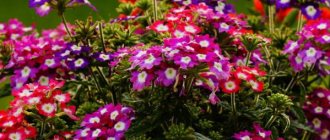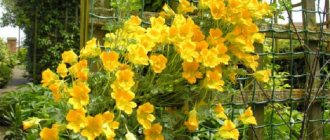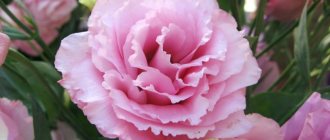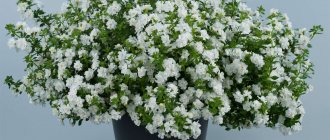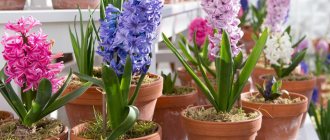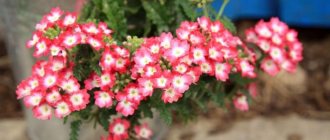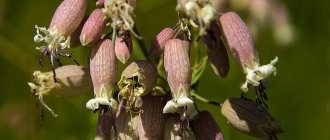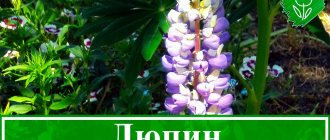An indispensable attribute of a summer cottage is a beautiful lawn with a large flower bed and bright flowers on it, a decorative green hedge, and ridges with ground cover plants. In recent years, a plant suitable for all types of decoration has increasingly appeared - this is Verbena.
The article was written with the information support of the director of Asia Strizh LLC - production of self-sharpening garden tools. Go to the garden tools catalog.
Description of varieties and their photos
Buenos Aires
This type of verbena is perennial.
Very impressive size. The height of the plant reaches from 1.3 meters to 1.6 - 1.8 meters. Its stems are straight and have purple flowers that grow in rather large inflorescences. Its aroma attracts bees from distant apiaries. Verbena Buenos Aires does not require special conditions for growth, due to which it is considered not whimsical. The only thing it needs is additional fastening, despite all the external strength of the stems - they are quite fragile. This species loves light more than others; it should be planted on the sunny side of the house.
Bonarskaya
A separately growing plant of this species gives the impression of a modest and particularly inconspicuous flower. But if you plant several flowers next to each other, then together they produce an incredible, eye-catching effect. It reaches a height of up to 1.5 meters, and its width can be about 50 cm. Verbena of this species is considered a cold-resistant plant, and it grows much better in warm and bright places, partial shade is acceptable.
Thanks to its resistance to frost and excessive precipitation in the form of heavy rains, it can be considered the real queen of the greenhouse. She still has a little whim. For good growth of bonar verbena, calcareous, loose and breathable soil is required. In order for it to please the eye for as long as possible with its bright purple blooms, those inflorescences that have bloomed should be removed immediately.
Important! In countries with colder climates, verbena bonarensis is an annual plant.
Home
An indoor, annual species of verbena, the size of which reaches half a meter in height. In a pot it takes the shape of a circle. It is distinguished by tetrahedral shoots and noticeably rough triangular leaves. The variety of flowers cannot but please the gardener. You can plant home verbena that is blue, pink, deep red, interspersed with a peephole, or the same type.
Reference! Verbena grows well next to flowers such as chamomile, rose, aster and marigolds; if you love decorative varieties of cereals, it will accept them into its environment, and your flower garden will gain some zest.
Spear-shaped
This variety of verbena is more resistant to cold than others. It is a perennial plant. A distinctive feature of this species is its variety of colors. Inflorescences can be white, lilac, purple and blue. If you grow this species of all the described flowers, then in combination they create indescribable admiration.
It mainly grows near rivers and small lakes, i.e. where the soil is significantly moist and rich in nutrients. The height of spear-shaped verbena can reach from 1 to 1.3 meters. You can always see flying bees and butterflies above it.
Canadian
Most often grown as an annual plant. Thin stems grow up to a maximum of 27 cm. Canadian verbena has white, red and light purple blooms, and the leaves have different shapes. It pleases with its massive bunches of inflorescences from the beginning of June until late autumn. During the flowering period, it can often be found in purple or lilac color. Seeds can be stored for several years.
Yellow perennial
The size of yellow verbena is average; when planting it, you should take into account the fact that this species has creeping shoots on which incredibly beautiful inflorescences bloom (all the nuances of planting and subsequent care of the plant can be found here). The name itself suggests that this is a perennial plant. The roughness and drooping leaves give them a kind of rigidity. The choice of shades of yellow verbena is very interesting; you can choose either a slightly bluish tint or a bright purple one.
When you grow yellow verbena, you should know some of the features of its cultivation, namely:
- Once it has been placed in open ground, it should not be watered with large amounts of water.
- It is best to stop watering when you see that its fruiting is running out.
- Verbena loves loose soil; after watering, be sure to let air into the soil.
Attention! When choosing places to plant plants, take into account the fact that it is better not to replant perennial flowers every year. An exception is made if the plant did not show excellent flowering in its original place and caused you a lot of trouble. You will find a detailed description of Fine-cut, Hybrid, Ampel and Medicinal verbena in separate articles
There we also talked about the care and reproduction of these varieties.
History and use
Simple and unremarkable at first glance, verbena is a sacred plant. The name itself comes from the Latin “word”, because it was verbena that was used in oaths and spells.
The ancient Celts prepared a drink of love from this flower and created protective amulets against evil spirits. And according to Christian legend, it was this flower that grew at the foot of the cross of Christ on Golgotha, and it was used to stop bleeding in wounds.
Photo: pinterest.ru
Verbena was a symbol of Venus, and was carried in amulet even during battles with enemies. It was believed that it gives beauty and youth, and in children it develops abilities and memory. They believed that verbena brings and preserves prosperity and wealth in the home.
Verbena wreaths strengthened friendships and marriages, and its juice tempered iron for swords and daggers. Healers treated all illnesses with it, and washed their hair with its decoction for headaches and worries. Witches used verbena flowers for their spells and love potions.
Photo: qscaping.com
Columnar apple tree: varieties, care and cultivation (photo)
The main difficulties in growing verbena
- The crop is often affected by powdery mildew. The problem mainly lies in the soil being unsuitable for cultivation. Usually, too much accumulated fluid inside the soil leads to infection. With all this, you should improve the composition of the soil mixture by adding humus or simple sand to it. The same problem occurs when verbena grows in too cold a climate in Russia. In this case, you need to choose those varieties that will be more resistant to infections and diseases, for example, hanging ones.
- Verbena cannot bloom or blooms too sparingly. Bad place to plant a plant. In this case, it is worth transplanting the plant to an area with brighter space. It should be noted that for high-quality formation of inflorescences, the flower must receive as much sunlight as possible.
When to plant depending on the region?
In most of Russia, Ukraine, and Belarus, Verbena seeds are planted throughout March. Only a few, the most experienced gardeners begin work in February. They do this so that at the beginning of May, and sometimes even in April, they can observe the flowering of this plant in their open garden.
However, it is important to remember that you should only replant bushes when there is no frost at night. If in April, according to forecasts for the middle zone, the onset of stable spring heat is expected, then you can start growing seedlings early
In the south of Russia and Ukraine, Verbena seeds are usually planted at the end of February and less often at the beginning of March. This is because already in April it is warm and light enough for the plant to be safely transplanted outside.
But in the northern regions the deadlines are expected to come later. To the north of the Moscow region, as well as in the Urals and most of Siberia, these flowers are sown in early April in order to be replanted in May-June, when more or less stable weather sets in without temperature changes.
Landscape design
The bright green lacy leaves, over which the heads of fragrant flowers rise for several months, serve as a wonderful decoration for the garden. Verbena is used in a mixed flower garden, as well as in group plantings along the border, walls and fences. You can plant flowers in flowerpots and flower pots, decorating balconies, terraces or verandas with them. Ampelous varieties form a beautiful cascade. Combining varieties with different flower colors is allowed.
In the flowerbed, verbena is combined with marigolds, asters, echinacea and cereals. Inflorescences should not be used in bouquets. Within a couple of days, the bright buds will begin to dry out and fall off.
Beneficial features
This herb contains a large amount of flavonoids, glycosides, vitamins, essential oils and trace elements. It is collected, dried and used in the preparation of tinctures and decoctions. The drugs have a diaphoretic, choleretic, and disinfectant effect. They are used in the fight against muscle spasms, fever, inflammation and colds. Tea with a sprig of verbena will help cope with fatigue, insomnia, nervous tension, hysteria and depression.
Lotions are widely used to cure scabies, boils, rashes and eczema.
Verbena is contraindicated for pregnant women, as the herb increases muscle tone, which can cause miscarriage. A nursing mother should also not take medications with verbena without consulting a doctor.
People prone to allergies should use drugs with caution.
Preserving verbena in the house in winter
Hybrid verbena can overwinter at home so that when warmer weather arrives, the gardener can plant it again in its original place in an outdoor flowerpot or flower garden. The plant does not tolerate frost or even light frost. Therefore, work with it is carried out in advance, without waiting for really cold nights.
Pot of blooming verbena on the windowsill
In autumn (September), all damaged, broken and withered shoots and inflorescences are cut off from the bush. The bush is dug up and moved to a pot of a suitable size. Then they are transferred to a bright room, where a stable temperature of 4-7 °C is maintained throughout the cold season. Periodically it is necessary to moisten the earthen ball, preventing it from completely drying out.
Important! Keeping the plant warm in winter is only possible with regular feeding and additional lighting, creating a daylight duration of 10-12 hours.
Growing verbena bonarensis in open ground
In order for Buenos Aires verbena to look as attractive as in the photo from the seed package, a number of conditions must be met. It requires a sunny area. As a last resort, partial shade is acceptable. The soil should be light and nutritious. In many cases, gardeners have to add sand to it.
Planting in open ground is usually carried out in May. The exact date is set depending on the region and weather in the current year. At this moment there should be a stable above-zero temperature and minimal risk of return frosts.
Transplanting seedlings
Planting of Bonarskaya verbena seedlings is carried out according to the following rules:
- the earthen lump must be preserved;
- the distance between neighboring plants is 20-30 cm;
- At the bottom of each hole you need to make a drainage layer.
Stagnant water is detrimental to verbena, so sand or expanded clay is poured into the bottom of the holes. After planting, the seedlings are watered. The top of the soil can be sprinkled with sand, sawdust or pine needles.
Watering and fertilizing
The sun quickly dries out the soil in which Bonarskaya verbena grows, so you need to carefully monitor soil moisture. The crop needs the most abundant watering during the period of budding and flowering. In the fall it should be reduced. Water should not be allowed to stagnate at the roots.
The plant does not need frequent feeding. It is enough to apply organic or mineral fertilizer 2-3 times a year. It is better to combine this event with watering. If you oversaturate verbena with nutrients, all its energy will be spent on growing green mass, and flowering will be poor.
During the flowering period, verbena "Bonarskaya" needs increased watering
Loosening, weeding, mulching
The first weeks after planting the seedlings, the soil will have to be frequently weeded and loosened. Later, when the Bonarskaya verbena bushes grow, these activities can be stopped. The dense branches and branched roots of the plant will prevent weeds from breaking through. This can be facilitated by mulch, which is used as shavings, sawdust or pine needles.
Wintering
Perennial Verbena "Bonarskaya" has become an annual crop in the middle zone and northern regions. The minimum temperature it can withstand is -3 °C. It does not tolerate winter frosts even with the most powerful shelter. Therefore, in October, verbena is removed from the site.
If a gardener plans to propagate verbena by cuttings in the spring, he should dig up several bushes in the fall. Until March they must be kept in a cool room. Seeds are collected for sowing at the end of the season. The ripened capsules are dried and then the seeds are removed.
Warning! Collected seeds of “Buenos Aires” verbena do not always retain the characteristics of the parent plants.
Landing in a permanent place
Although verbena is quite unpretentious, it should be planted in a well-lit place. In the shade, flowers will appear later and will be pale in color. The bush can be transplanted into a pot much earlier and regularly transferred to the most illuminated areas.
Verbena does not like stagnation of moisture at the roots, so when transplanting into open ground, a drainage layer of expanded clay or crushed stone is placed in the holes. Otherwise, the root system will rot. To obtain beautiful and voluminous bushes, plants are transplanted in groups of 5-7 pieces. into one hole with a distance between them of at least 30 cm.
Detailed characteristics of plant species with photos
The birthplace of the flower is North and South America. This is an annual or perennial plant with various variations of names (blood of Mercury, cast iron grass, tears of Juno, witchcraft plant).
In our country, the flower is usually grown for 1 season (cultivated as an annual). The height depends on the specific variety: from 25 cm to 1.5 m.
The plant is characterized by serrated leaves in the form of an elongated oval and bright inflorescences (1 can contain up to 50 small flowers). The color is expressed in a wide range of shades: from delicate pastels to rich dark ones.
Specific external characteristics depend on the particular variety. Among the general characteristics note:
- stems straight or creeping,
- Flowering period from early summer to October,
- each flower has 5 petals (corolla shape),
- thermophilic character,
- The seeds are small in size and ripen in small boxes.
Ideas for use: decorating flower beds and flower beds, creating decorative elements (pots), planting in hanging baskets.
Buenos Aires verbena
This is an unpretentious subspecies that is distinguished by purple inflorescences and straight stems.
The diameter of the inflorescence is no more than 5 cm. Their smell and brightness attract bees. Verbena Buenos Aires quickly adapts and takes root with any other varieties of flowers. In warm climates it is used as a perennial, in cold climates it is used as an annual (planting seedlings). Initially, the subspecies grows in 1 stem, then shoots form from the lateral axils and the main stem becomes woody. The height of the bush is 120-130 cm. The shape of the leaves is lanceolate, elongated, with teeth visible along the edges. Mass ripening and flowering occurs in September.
Verbena Bonarskaya
This is a subshrub with a straight stem, the height of which reaches 100 cm. The subspecies is widespread in the field of decorative floriculture. The foliage is emerald green and lacy in shape, the flowers are collected in dense umbrellas.
The predominant color of the inflorescences is purple. In our country, Verbena Bonarskaya is grown as an annual (propagation through seedlings). Seeds should be sown in the soil mixture in early March, and ready-made seedlings should be planted in open ground no later than the end of May.
Important advantages of the subspecies are resistance to slight autumn frosts and lack of careful care. It is enough to plant the plant in a sunny place where the soil is fertile and drained. As a result, a dense lilac fog of bright flowers will envelop the flower garden, attracting bees and butterflies. The subspecies also retains freshness for a long time when cut.
Below is a video about Verbena Bonarskaya:
The domestic verbena variety is popular for indoor growing. This is a low annual (up to 50 cm), with a flower of a regular round shape, unlike Buenos Aires verbena. Other characteristics include:
- shoots tetrahedral and branched,
- triangular leaves, rough surface,
- shoots are covered with hard hairs,
- pleasant aroma of inflorescence,
- variety of colors (verbena pink, red, blue with a white eye or the same type).
Spear-shaped
In its homeland, the subspecies grows on the banks of rivers and lakes, preferring moist, rich soils. It can overwinter in the ground only in Europe. The plant is distinguished by its elegant appearance, stem height (up to 1.5 m), and spear-shaped inflorescence.
Common colors are blue, purple. Also, spear verbena is an excellent honey plant; it emits a fragrant, rich aroma. Flowers can quickly fall off, but even a half-shattered inflorescence retains its original and beautiful appearance.
The peculiarity of Canadian verbena is its low stem (no higher than 20 cm). The stem is tetrahedral (not like the Bonar variety), with carved leaves arranged in pairs around it.
The buds are collected in bunches. Possible flower color options include pink, white, and soft lilac.
Yellow perennial
This is a voluminous small bush with elongated leaves. The shoots of yellow verbena are creeping, with small inflorescences located on their tops.
The leaves are drooping, the surface is hard. The variety is distinguished by a variety of shades: from pale blue to rich purple.
Agricultural technology
There is always a place for parsley in the garden. The plant is unpretentious and has almost no demands on the soil. However, in well-lit places with loose, fertile soil, parsley can produce a particularly good harvest.
Sowing and cultivation
The best predecessors for parsley are zucchini, cucumbers, potatoes and cabbage. It should not be planted after other celery plants - carrots, celery, cilantro, cumin, etc., but it can be grown perfectly at the same time as them. Parsley grows well in mixed plantings with radishes, peppers, peas, tomatoes and cucumbers. In the area where parsley grew, it can be sown again only after four years.
The place for future planting of parsley is prepared in the fall, the soil is dug deeply and compost is added. In spring, the soil is loosened and fertilized with complex mineral fertilizers.
Parsley seeds are sown directly into the ground from mid-April. Dry seeds have difficulty germinating, so before sowing they must be soaked in water for half an hour and then dried until they flow. For sowing, furrows are made in the beds with a depth of 1–1.5 cm and spilled with water. After the moisture is absorbed, seeds are sown in the grooves and covered with soil. The earth is leveled and slightly compacted.
Usually the seeds germinate within 15–20 days. To speed up seed germination, the bed can be covered with film. As soon as the shoots appear, the film is immediately removed, since young shoots need good lighting. Parsley seedlings are not afraid of frost down to -9 degrees.
Leafy varieties of parsley can be sown during the summer until the end of July.
Before winter, parsley is sown with dry seeds (without soaking) on beds to a depth of about 1 cm. The beds are mulched with humus or peat.
Feeding
Leaf parsley is fed 1–2 times a season with nitrogen fertilizer (50–60 g of nitrate for every 10 sq. m). Root parsley is fed at the beginning of the growing season with complex fertilizer, and in August phosphorus-potassium fertilizers are given at the rate of 70 g of superphosphate and 50 g of potassium salt per 10 square meters. m. Nitrogen fertilizers are no longer used in order to prevent root crops from being depleted.
Harvest
Leaf parsley is harvested as needed throughout the growing season until the end of August. Root crops are harvested before the onset of steady cold weather.
Storage
Root parsley is stored in the refrigerator or cellar like carrots. Some plants can be left in the ground to get early greenery next spring. Parsley overwinters well in open ground and freezes out only in very cold, snowless winters.
Pests and diseases
Parsley in general is characterized by the same diseases and pests as other umbelliferous plants, but it is rarely affected by pests and diseases.
Parsley leaves and stems can be affected by downy mildew, rust, white spot, leaf blight, stem nematode of onion and garlic, and melon aphid. Root parsley can suffer from white rot. Both leaves and roots of parsley can be affected by carrot psyllid.
Rules for planting verbena
Seeds
In open ground
Plant verbena seeds in open ground in specially prepared grooves. They should be located at a distance of 0.7 m. Sprinkle with earth and water. After 10-14 days, the first shoots appear. Now is the time to apply liquid mineral fertilizer.
At home
Since verbena is excellent for growing on the balcony, the seeds are planted according to the following scheme:
- Scatter the prepared planting material over the surface. The soil should be soft and loose. You can sprinkle a little sand.
- Moisten the substrate, but do not flood it. A spray bottle is suitable for these purposes.
- Cover the container with glass or film to create a greenhouse effect.
- If seed stratification has not been carried out previously, then place the containers in the refrigerator for 2-3 days. Under the influence of low temperatures, seeds are stimulated, as a result of which the first shoots appear earlier, they grow quickly and bloom profusely.
- The seedlings should be near the battery. The temperature before emergence should be 20-25 degrees.
- The soil must be moistened periodically using a spray bottle. The soil should not be allowed to dry out or become overly wet. You will be able to see the first shoots in 1-3 weeks.
- Now you can remove the film and move the container to a well-lit and cool place.
- Plant seedlings into pots when the seedlings grow to 2-3 true leaves and their height reaches 8-10 cm.
Seedlings
- It is necessary to plant ready seedlings in holes located at a distance of 20 cm. If the species are creeping, then increase the distance to 25-35 cm.
- When the soil is excessively dry, add 1.5 liters of water to each planting hole.
- Wait until it is absorbed, and then place the roots of the plant into the resulting slurry.
- Now sprinkle the wet lump with the seedling flower with dry soil and lightly press the soil near the crop.
- In the first 1-2 weeks, water the plant thoroughly. This will allow it to quickly take root and bloom earlier.
If the seedling method is chosen, then the seeds are planted in a prepared container and substrate in early March. When growing verbena in the southern regions, planting material can be sent directly into the ground in late April-early May.
Transplantation and care in the flower garden
Gardeners consider the plant to be an unpretentious flower. Young bushes can withstand frosts down to 2 °C and drought for a short time. Even a beginner in floriculture can cope with planting and growing bonar verbena.
Transplant timing
Both seedlings and rooted cuttings are planted in flower beds when the threat of spring cooling has passed. The specific timing is affected by the location of the region.
Table 1.2 – Planting dates by region
| Region | Transplant timing |
| southern latitudes | from April 15 |
| Moscow region, central regions | from May 15 |
| Siberia, Ural | from May 25 |
When growing and caring for, bonar verbena is unpretentious; it does not require special conditions.
To ensure lush and long flowering, the gardener only needs to provide:
- High-quality soil: loose and nutritious;
- Moderate irrigation, without stagnation of water in the soil;
- Fertilizers that are applied regularly throughout the growing season, at least 4 times.
Description of the plant
The most popular is Argentinian verbena, or as it is also called Bonar, or Buenos Aires. The inflorescences of the bush resemble fluffy clouds, and in its latitudes it is cultivated as a perennial flower. If you grow verbena using the planting method, the height can be more than one and a half meters.
Verbena Buenos Aires
It goes well with decorative conifers, herbs and other tall perennials. Although the plant reaches a great height, it does not need to be tied up. When flowering, small purple umbels open at the top, from which lilac flowers appear.
Types of verbena
The most popular verbena in Russia has become the Bonar verbena Lilac Rain. The unpretentiousness of this species was the main reason why gardeners chose it out of all the abundance. There are other plants of the family that can be used for cultivation in Russian latitudes:
- hybrid. These include red-flowered Cardinal, light purple Julia, large-flowered Pink Fairy;
- varieties Lylek and Fyness, capable of attracting bees to the site with their aroma;
- verbena is tough with stems creeping along the ground. Its most famous variety is Polaris, which has beautiful blue flowers.
For your information! All types of verbena grown by seedlings tolerate cold and even light frosts quite well.
Types of verbena
Let's look at some types of verbena:
1. Buenos Aires verbena (V. bonariensis L.), or bonar verbena, also known as Argentine verbena, is a tall plant about 120 cm in height, has erect bushes with a pronounced main stem. The flowers collected in spikelets are amethyst in color. Flowering is abundant and long until late autumn. It is a perennial, but in our climate it is grown as an annual plant. Seeds are sown for seedlings in March. It is planted in the flower garden in large groups (at least 10 pieces) in the background so that the “bottom” is covered with other plants. The “cloud” of Buenos Aires verbena will perfectly complement any flower garden, looks good with ornamental grasses, and will sit beautifully next to tall golden roses.
3. Rigid verbena (V. rigida Spreng.). In our climate it is grown as a summer plant. It has branched tetrahedral stems that creep or ascend from the base, hard elongated leaves that are hairy below and flowers of lilac-purple color. Blooms profusely from June to October.
4. Canadian verbena (V. canadensis (L.) Britt.) Has thin stems about 20 cm in length, oval elongated leaves and flowers of white, pink or lilac color. Grown as an annual. Blooms from June to late autumn.
general characteristics
Verbena belongs to the family of simple and unpretentious herbaceous plants of the same name. These can be small shrubs, a thick flowering carpet, or even tall, straight subshrubs up to several meters tall.
Verbena flowers are always small, up to a maximum of 2.5 cm, but at the same time they are collected in dense inflorescences and brushes. The color spectrum is wide and varied: from white and yellow to pink, dark red and even blue or dark blue.
Some varieties of verbena are actively used in medicine for the treatment and prevention of digestive problems. In cooking, it is often used for flavor in the preparation of preserves and preparations. Medicinal verbena is also in demand among beekeepers and honey lovers.
Photo: domashniecvety.ru
What types and varieties of verbena exist?
Verbena breeders have been able to produce about 250 new and unusual species, each with its own unusual traits and characteristics.
Hybrid verbena is the most popular variety among gardeners. Hybrid verbena growing from seeds is not difficult. The bush looks quite compact, the degree of branching is high with creeping stems, the height of the crop reaches 50 centimeters. The flowers have different colors. Based on differences in varietal character, verbena can be divided into two main groups:
- Large-flowered (Julia, Cardinal, Defas, Etna, Bonarskaya).
- Compact flowers (Amethyst, Dazler, Pink Delight, Crystal).
- Canadian verbena is a plant that is commonly grown as an annual. The stems of the crop are particularly thin and can reach a height of about 20 centimeters. During the flowering process, the plant is covered with a large number of white, pink and lilac flowers.
- Hard verbena is a crop that is distinguished from others by its small flowers of a lilac hue, which together form beautiful inflorescences. Stems are tetrahedral, creeping. The germination of mature seeds is not able to persist until the five-year mark.
- Buenos Aires verbena is a tall plant, reaching 120 centimeters. The stems of the flower are erect and also of a durable type. The side shoots of the plant, as a rule, extend from the base of the bush. At the same time, a large number of small flowers of an amethyst hue can form on a flower, which are collected in large caps of inflorescences.
- Ampelous verbena is a fast-growing annual species. Flower growers use it mainly for growing in pots. The shoots can grow up to 60 centimeters, while they gracefully hang down. The inflorescences of this variety are quite small and have flowers of various colors.
- It is also worth mentioning separately about lemon and medicinal verbena. These are perennial shrubs whose flowers contain medicinal properties that can help a person reduce blood pressure and also act as a good antispasmodic during intestinal disorders. Verbena oil can be used as a good antiseptic.
Varieties of verbena
Care
This type of verbena is named after the city of Buenos Aires. In the Argentine climate, this plant is perennial. It prefers sun, moderately moist soil. Able to survive extreme heat, drought, and low temperatures.
Ampel verbena - growing in a pot, planting and care
The flower is unpretentious and does not require complex care, but some rules should be followed:
- it needs to be grown in a spacious, sunny place;
- seedlings must be watered frequently. In the first month, this needs to be done every day. At the same time, excess moisture can destroy small sprouts. Sometimes, at the planting site, under the top layer of soil, drainage is arranged for them;
- Complex fertilizers for flowering plants are applied as top dressing. Humus is not suitable, its excess can lead to the growth of the bush and the rare formation of umbrellas;
- In the first weeks after planting, the soil around the seedling must be loosened regularly. If the bushes are already large, you can mulch the ground;
- for beautiful flowering you will need to trim off the wilted buds;
- the plant is rarely affected by diseases. It is treated with insecticides against aphids. Powdery mildew or fungal diseases are treated with foundationazole, drugs that contain sulfur.
Important! Growing such a flower in your own garden is easy even for an inexperienced gardener. Verbena does not require much attention. Will survive drought and lower temperatures, interruptions in watering and heavy rain. Until frost, it will delight owners with umbrellas of bright colors. Will decorate any flower bed, clearing on the site, border, area between bushes.
Pests and diseases
Verbena resists diseases well. But in warm rainy periods it is threatened by fungal diseases: powdery mildew and various rots. Affected areas should be removed immediately and the remaining parts of the plant treated with an appropriate fungicide. Basic measures to prevent diseases:
- moderate watering;
- removing faded inflorescences;
- weed removal.
Verbena "Bonarskaya" can become a victim of two types of pests: leaf miners and aphids. They gradually destroy the leaves of the plant. For prevention, they are regularly inspected and sprayed with special preparations.
How to care for verbena seedlings
Caring for seedlings of this flower after sowing is not very different from the principles of caring for seedlings of other vegetable and flower crops. The main points of growing plants from seeds before and after germination are standard.
You need to care for verbena seedlings as follows:
- After sowing, the container with soil and seeds must be covered with film, glass or a lid (to create a mini-greenhouse). Every day, until seedlings emerge, you should ventilate the crops for 20-25 minutes, removing the covering material. Don't forget to remove condensation from it with a napkin.
- Immediately after sowing, it is recommended to place the container in a place with a temperature of +22-25°C.
- After the first shoots appear, it is necessary to remove the covering material. And in order for young plants to more easily tolerate changing conditions, this must be done gradually - on the first day, the film or glass is removed for 30 minutes, and then the time increases and after a few days it is completely removed.
- After the emergence of seedlings, the temperature regime also changes - now the temperature should be maintained in the region of 15-18 degrees Celsius.
Lighting is very important for young seedlings. The optimal length of daylight is 12-14 hours, so it is necessary to provide additional light to the seedlings.
Watering before germination of seedlings should be done from a spray bottle. Moisture should be added regularly so that the soil is always moderately (!) moist.
After the emergence of seedlings, you need to water at the root, using, for example, a syringe
Water should not get on the plants themselves. Plants should not be over-watered, so water after the top layer has slightly dried.

